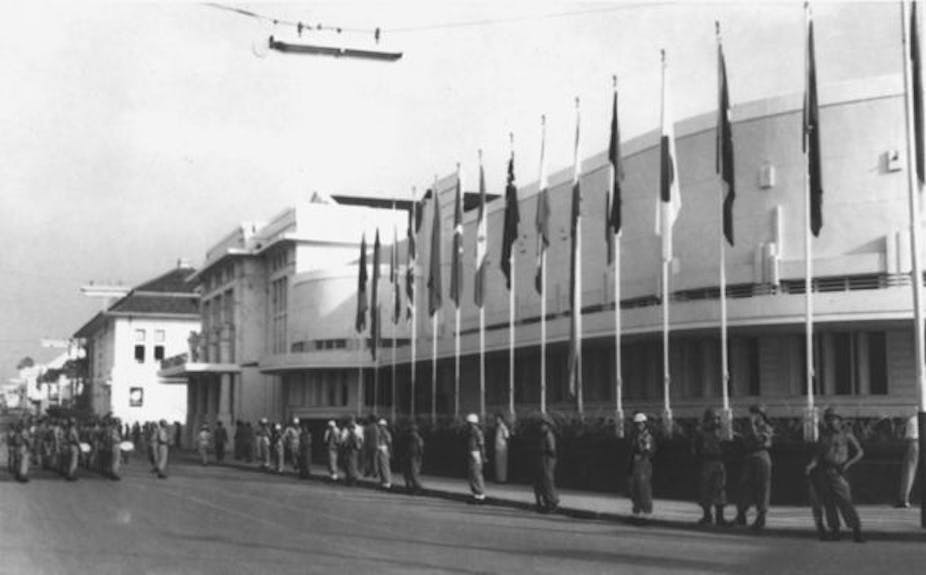“Yes, there has indeed been a "Sturm uber Asien” – and over Africa too. The last few years have seen enormous changes … The passive people have gone … The mental, spiritual and political face of the whole world has been changed, and the process is still not complete.“
*President Sukarno, opening speech of the Asian-African Conference 1955 *
Indonesia is hosting the 60th anniversary commemoration of the Asian-African Conference from April 19-24. Jakarta has put considerable effort into organising the event to make it a success. But the world interest in the event today does not compare to the attention given to the original Asian-African Conference.
The conference in Bandung from April 18-24, 1955, was held in the midst of the Cold War between the United States and Soviet Union. The Indonesian government had raised the idea for the conference in April 1954. Leaders of Indonesia, India, Pakistan, Burma and Ceylon (now Sri Lanka) met on December 1954, agreeing that they would jointly propose the conference.
Newly independent nations defying the superpowers
The United States and its allies, fearing that countries of Asia and Africa would side with the Communist bloc, watched the developments in Bandung closely.
The Asian-African Conference was the first gathering of Asian and African countries that were newly independent from centuries of colonial rule. They organised the event without the involvement of external powers. Delegates from 29 Asian and African countries attended.
China claimed that "imperialist powers” tried to sabotage the event, or at least Chinese participation. The Chinese believed the US masterminded an attack on a passenger plane carrying Chinese delegation.
The Spirit of Bandung
Despite the tension, the conference produced a final communique laying out the direction of cooperation between Asian and African countries.
In the document, countries pledged to build economic cooperation. They supported the struggle for self-determination by calling for the end of racism (in their view, racism is strongly connected to colonialism). They also unanimously adopted a declaration of the Ten Bandung Principles (Dasasila Bandung).
Observers of the 1955 conference summed it up with the term “The Spirit of Bandung”. This captures the defiant mood of the newly independent countries amid the antagonistic rivalry between the US and USSR.
It is a call for peaceful coexistence between nations, for freedom from hegemony of any superpower and any kind of domination by another country. It promotes solidarity with the poor, colonised, exploited and those weakened by the world order of the day.
Impacts of Asian-African Conference
The conference aimed to change the relationship between developing and developed countries. It led to the establishment of the Non-Aligned Movement (NAM). It also introduced the term “Third World”.
The “Third World” referred to Asian, African and other developing countries in Latin America that refused to side with one of the Cold War blocs. It also described an emerging community of nations that shared a colonial experience.
The new coalition used this unique characteristic of developing countries to resist the exploitation of former colonies under the new architecture of global politics that emerged from de-colonisation.
This concept led to the introduction of the idea of the “right to development”. Developing countries, unsatisfied with the Bretton Woods monetary system, pushed for the New International Economic Order (NIEO). They did not manage to replace the Bretton Woods system, but their efforts gave rise to the UNCTAD (United Nations Conference on Trade and Development), a UN body responsible for dealing with development issues through trade.
Developing countries pushed for the adoption of the Charter of Economic Rights and Duties in 1974. This charter acknowledges the importance of restructuring the world’s economy to allow greater participation of developing countries.
They also set up the South-South Cooperation, a UN framework for collaboration between developing countries. This was to ensure that developing countries were able to escape the fate of “dependency” in “North-South” economic relations.
Developing countries, inspired by the solidarity gained from the Asian-African Conference, continued to push for economic reforms between 1950s and 1970s. But their vigour started to fade in 1980s with leadership changes in each of the conference’s founding countries. Many legacies of the conference remain, but most of them are becoming less important even for Asian and African countries.
This year, the commemoration of the conference returns to solidarity between developing countries. The topic of this year’s commemoration is “Advancing South-South Cooperation”.

